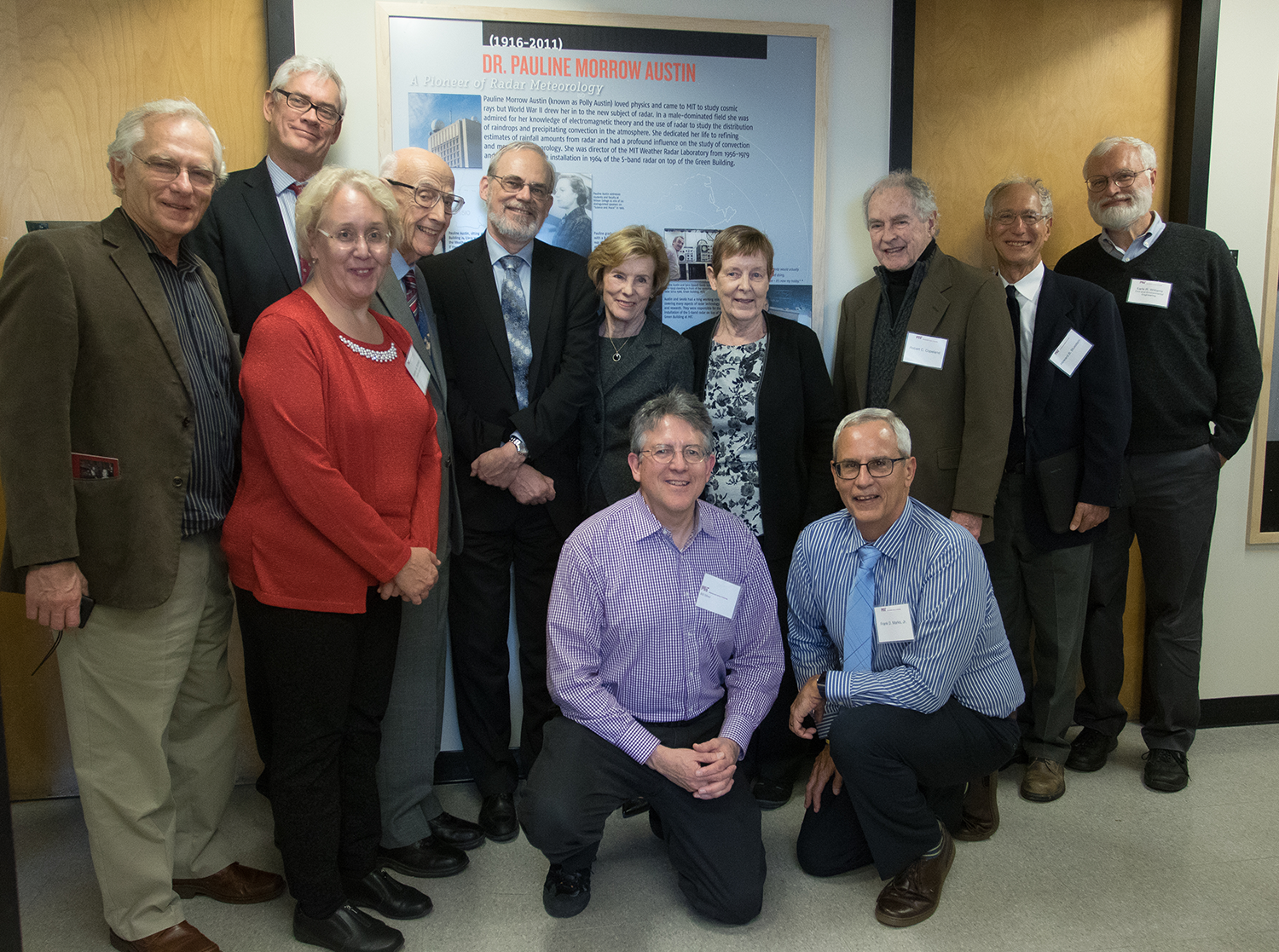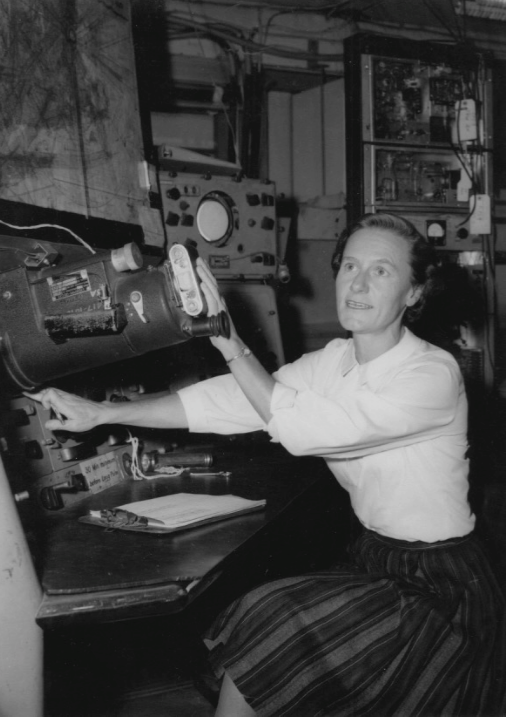PAOC Spotlights
Celebrating Pauline Morrow Austin: A Founder of Radar Meteorology
MIT Faculty, friends and family of Mrs. Austin gathered to remember her life and commemorate her contributions to science with the unveiling of an exhibit in EAPS.

Modern meteorology would not be what it is today without contributions from MIT’s Pauline (Polly) Morrow Austin PhD ’42 and a long-time Director of MIT’s Weather and Radar Research Project, and last December, MIT recognized her influence on the field of weather radar with a centennial celebration. Throughout the day, MIT faculty, students and Austin friends and family gathered in the Department of Earth, Atmospheric and Planetary Sciences (EAPS) to remember her work, share personal moments, and discuss current weather and climate-related research. The events of the day built to the unveiling of an exhibit on the 16th floor showcasing Dr. Austin’s meticulous application of radar to weather study and MIT’s role in its development. A generous gift from one of Dr. Austin’s long time colleagues and MIT alum made this possible, as well as new equipment for the Synoptic Meteorology Lab, including a weather camera, weather stations and a display screen for meteorological data, all in Polly’s honor.
“The glass ceiling was not something that Polly acknowledged and continuously broke,” said Polly’s daughter Doris Austin Lerner.
 As one of the first women to graduate from MIT with a doctorate in Physics and work in the field of weather radar, Polly set the bar high. She came to MIT in 1939 with degrees in mathematics and physics, and began working with Prof. Julius Adams Stratton, a future president of MIT, on electromagnetic theory and radar, which was developed in England during World War II. Anxious to develop the technology further, radar research was moved to MIT, where Polly became involved.
As one of the first women to graduate from MIT with a doctorate in Physics and work in the field of weather radar, Polly set the bar high. She came to MIT in 1939 with degrees in mathematics and physics, and began working with Prof. Julius Adams Stratton, a future president of MIT, on electromagnetic theory and radar, which was developed in England during World War II. Anxious to develop the technology further, radar research was moved to MIT, where Polly became involved.
She joined the Radiation Laboratory (Rad Lab) at MIT, studying the reflection of megahertz radiowaves off of the ionosphere to extend Long Range Navigation (LORAN) from ground waves to skywaves, shared Earle Williams, Senior Engineer of Civil and Environmental Engineering, during the course of the day. This classified work was crucial to the wartime effort and brought her recognition from the New York Times in an article “Special Roles Vital to Nation Filled by Women Scholars.”
After completing her thesis work on the “Propagation of electromagnetic pulses in the ionosphere”, and with Stratton’s encouragement, Polly joined MIT’s Weather Radar Research Project at its inception in 1946. This was the first critical investigation into how radar technology could be used to monitor weather; she focused on comparing measurements of actual rainfall with those found using radar. “She really had a love affair of measuring rainfall with radar and doing it quantitatively, and she did that for decades. The seeds of that came from the Rad Lab, but she was really working on that until 2004 when she was at MIT the last time,” said Williams. Later, Polly went on to direct the Weather Radar Research Project until she retired.
The scope of Dr. Austin's research extended further yet, and arguably she’s best known for her work on a weather radar phenomenon called the “bright band.” This is a feature seen on radar that delineates between rain and snow as you go vertically in the atmosphere, and helps with weather pattern classification. Her work here is still referenced today and can literally be seen across America. “The reason that the whole United States is covered with s-band radar, it’s probably safe to say, [is] because of Polly Austin. In Europe, there are many networks of c-band radars, but Polly knew that if you wanted accurate [rain] measurements, you had to go with s-band,” said Williams. Polly was also instrumental in installing radomes on MIT’s Green Building (EAPS).
Polly also chaired the American Meteorological Society’s Committee on Radar Meteorology from, and in 1974, she was the first woman to be elected a councilor.
Dr. Austin, as her students remembered her, was more than a brilliant mind; she was a mentor and scrupulous advisor. Looking on a photo of Polly, Robert A. Houze Jr., Prof. of Atmospheric Science at the University of Washington, remarked, “There’s the intelligence in the eyes, the smile, and the soft look that sort of hides the fact she was as tough of an advisor as you’d ever imagine, which was to my great benefit.” She questioned results with a fine-toothed comb, provided constructive feedback and demanded clarity of thought in scientific writing—an experience each of her former students was all too familiar with. But all present at EAPS on Pauline Austin Day expressed a high level of appreciation for the opportunity to work with her. Robert A. Houze Jr. summed it up, “I’m not exaggerating that this mentorship has had a lasting influence that goes right up through today.”

Several of her students, children and contemporaries shared moments spent with Dr. Austin and MIT's involvement with radar development, including Howard Bluestein, Robert C. Copeland, Kerry Emanuel, Robert A. Houze, Jr., Lodovica Illari, Frank D. Marks, Jr., William M. Silver, Melvin L. Stone, Earle Williams, Marilyn M. Wolfson, and her daughters Doris Austin Lerner and Dr. Carol West.
Following remembrances, attendees of the celebration explored current departmental research through a poster session. Presenters included Vince Agard, Brian Green, Mukund Gupta, Michael McClellan, Diamilet Perez-Betancourt, Madeleine Youngs, Emily Zakem and Maria Zawadowicz. They also toured the Synoptic Lab, posed for photos in front of Polly’s radomes on the roof of the Green Building, and watched as Polly’s daughters unveiled the new exhibit honoring Dr. Austin and MIT’s radar work.
Thinking back on Dr. Austin, William M. Silver of the MIT Weather Radar Research Project, described Polly as “mild mannered”—as many before him had done—but noted that Superman’s Clark Kent shared a similar disposition. However, Polly’s power emanated from her intellect. “Now, that great laboratory is long gone. All that remains, the iconic radomes on the roof…And as that great laboratory fades from the memory of this building, this institute, let’s at least not forget Pauline Austin, class of ’42, PhD physics—one of the founders of radar meteorology [with a] mind of steel.”
Special thanks to program participants:
Howard B. Bluestein, ‘70 (VI), SM ‘72 (VI), PhD ‘76 (XIX)
Professor of Meteorology, University of Oklahoma
Robert C. Copeland, SM ‘57 (XIX)
TV Meteorologist (retired)
Robert A. Houze, Jr. SM ‘69, PhD ‘72 (XIX)
Professor of Atmospheric Sciences, University of Washington
Lodovica Illari
Senior Lecturer, Department of Earth, Atmospheric and Planetary Sciences
Doris Austin Lerner
Daughter of Pauline and James Austin
Frank D. Marks, Jr.
Director of Hurricane Research Division, AOL, NOAA
William M Silver ‘75 (VI), SM ‘80 (VI)
Student Technician and Research Staff, MIT Weather Radar Research Project (1973-1980)
Melvin L. Stone, ‘51 (VI)
Senior Staff, Lincoln Laboratory
Robert van der Hilst
Head of the Department of Earth, Atmospheric and Planetary Sciences
Carol West
Daughter of Pauline and James Austin
Earle Williams PhD ‘81 (XII)
Senior Engineer, Civil and Environmental Engineering
Marilyn M. Wolfson SM ‘83 (XIX), PhD ‘90 (XII, XII D)
Fellow, Lincoln Laboratory